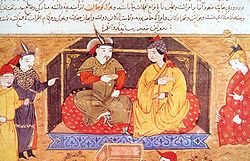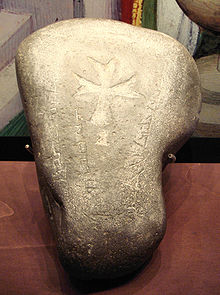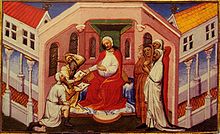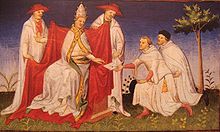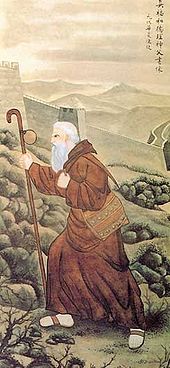- Christianity among the Mongols
-
For Christianity in the modern era, see Christianity in Mongolia.Hulagu, grandson of Genghis Khan and founder of the Mongol Ilkhanate, seated with his Christian queen Doquz Khatun of the Kerait clan
 See also: History of Eastern Christianity in Asia and Nestorianism
See also: History of Eastern Christianity in Asia and NestorianismIn modern times the Mongols are primarily Buddhist, but in previous eras, especially during the time of the Mongol "empire" (13th–14th centuries), they were primarily shamanist and had a substantial minority of Christians, many of whom were in positions of considerable power.[1][2] Overall, Mongols were highly tolerant of most religions, and typically sponsored several at the same time. Many Mongols had been proselytized by Nestorian Christians since about the 7th century,[3] and some tribes' primary religion was Nestorian. In the time of Genghis Khan, his sons took Christian wives of the Kerait clan, and under the rule of Genghis Khan's grandson, Möngke, the primary religious influence was Christian.
The practice of Nestorian Christianity was somewhat different from that practiced in the West, and Europeans tended to regard Nestorianism as heretical for its beliefs about the nature of Jesus. However, the Europeans also had legends about a figure known as Prester John, a great Christian leader in the East who would come to help with the Crusades. One version of the legend connected the identity of Prester John with a Christian Mongol leader, Toghrul, leader of the Kerait clan.
When the Mongols conquered northern China, establishing the Yuan Dynasty (1271–1368), Nestorian Christianity was re-introduced to China after a gap of centuries. As the Mongols further expanded, the Christian sympathies of the court, primarily through the influential wives of the khans, led to changes in military strategy. When the Mongols conquered Baghdad in 1258, many of the citizens of the city were massacred, but the Christian inhabitants were spared. As the Mongols further encroached upon Palestine, there were some attempts at forming a Franco-Mongol alliance with the Christians of Europe against the Muslims.
Mongol contacts with the West also led to many missionaries, primarily Franciscan and Dominican, traveling eastward in attempts to convert the Mongols to Roman Catholicism.
Contents
Background
 The Nestorian Stele in China, erected in 781
The Nestorian Stele in China, erected in 781
The Mongols had been proselytised since about the 7th century.[4][5][6] Many Mongol tribes, such as the Kerait,[7] the Naimans, the Merkit, the Öngüd,[8] and to a large extent the Kara Khitan (who practiced it side-by-side with Buddhism),[9] were Nestorian Christian.[10]
Genghis Khan himself was a Shamanist, but was tolerant of other faiths. When, as the young Temüjin, he swore allegiance with his men at the Baljuna Covenant around 1200, there were representatives of nine tribes among the 20 men, including "several Christians, three Muslims, and several Buddhists."[11] His sons were married to Christian princesses of the Kerait clan who held considerable influence at his court.[12] Under the Great Khan Mongke, Genghis's grandson, the main religious influence was that of the Nestorians.[13]
Some of the major Christian figures among the Mongols were:
- Sorghaghtani Beki, daughter in law of Genghis Khan by his son Tolui, and mother of Möngke, Kublai Khan, Hulagu Khan and Ariq Boke, who were also married to Christian princesses;[12][14][15]
- Doquz Khatun, wife of Hulagu and mother of the Ilkhan Abaqa,[16] who for his part married Maria Palaiologina, daughter of Byzantine Emperor Michael VIII Palaeologus in 1265. After the death of Arghun's mother Doquz, Maria filled her role as a major Christian influence in the Ilkhanate.
- Sartaq, son of Batu, who converted to Christianity during his lifetime;[17]
- Kitbuqa,[18] general of Mongol forces in the Levant, who fought in alliance with Christian vassals.
- Mar Yaballaha III, an Ongud Mongol earlier known as Rabban Marcos, who became the highest authority (Patriarch) of the Nestorian church from 1281 to 1317.[19]
- Rabban Bar Sauma, Chinese monk who made a pilgrimage from Khanbaliq (Beijing), and testified to the importance of Christianity among the Mongols during his visit to Rome in 1287.
Practice
According to popular anthropologist Jack Weatherford, because the Mongols had a primarily nomadic culture, their practice of Christianity was different from what might have been recognized by most Western Christians. The Mongols had no churches or monasteries, but claimed a set of beliefs that descended from the Apostle Thomas, which relied on wandering monks. Further, their style was based more on practice than belief. The primary interest in Christianity for many, was the story that Jesus had healed the sick and survived death, so the practice of Christianity became interwoven with the care of the sick. Jesus was considered to be a powerful shaman, and another attraction was that the name Jesus sounded like Yesu, the Mongol number "9". It was a sacred number to the Mongols, and was also the name of Genghis Khan's father, Yesugei.[20] However, somewhat in contradiction to Weatherford, there is written evidence of a permanent Nestorian church in Karakorum[21] and archeological evidence for another permanent Nestorian church in Olon Süme.[22] The use of non-permanent (yurt) churches is also well-documented.[22]
Again according to Weatherford, the Mongols also adapted the Christian cross to their own belief system, making it sacred because it pointed to the four directions of the world. They had varied readings of the Scriptures, especially feeling an affinity to the wandering Hebrew tribes. Christianity also allowed the eating of meat (different from the vegetarianism of the Buddhists). And of particular interest to the hard-drinking Mongols, they enjoyed that the consuming of alcohol was a required part of church services.[23]
Women in Mongolia were known to indicate their faith by wearing an amulet inscribed with a cross, or to be tattooed with a cross.[24]
Kerait and Naiman Christian tribes
The Kerait tribe of the Mongols were converted to Nestorianism early in the 11th century. Other tribes evangelized entirely or to a great extent during the 10th and 11th centuries were the Naiman tribe. The Kara-Khitan Khanate also had a large proportion of Nestorian Christians, mingled with Buddhists and Muslims.
An account of the conversion of the Kerait is given by the 13th century Jacobite historian, Gregory Bar Hebraeus, who documented a 1009 letter by bishop Abdisho of Merv to the catholicos John VI which announced the conversion of the Keraits to Christianity.[26] According to Hebraeus, in the early 11th century, a Kerait king lost his way while hunting in the high mountains. When he had abandoned all hope, a saint appeared in a vision and said, "If you will believe in Christ, I will lead you lest you perish." The king returned home safely, and when he later met Christian merchants, he remembered the vision and asked them about their faith. At their suggestion, he sent a message to the Metropolitan of Merv for priests and deacons to baptize him and his tribe. As a result of the mission that followed, the king and 20,000 of his people were baptized.[27][28]
The legend of Prester John was also connected with the Nestorian rulers of the Kerait. Though the identity of Prester John was linked with individuals from other areas as well, such as India or Ethiopia, in some versions of the legend, Prester John was explicitly identified with the Christian Mongol Toghrul.
Relations with Christian nations
Main article: Franco-Mongol alliance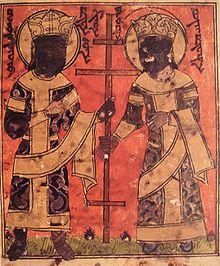 Hulagu and his wife Doquz Khatun in a Syriac Bible
Hulagu and his wife Doquz Khatun in a Syriac Bible
Some military collaboration with Christian powers took place in 1259-1260. Hetoum I of Cilician Armenia and his son-in-law Bohemond VI of Antioch had submitted to the Mongols, and, as did other vassal states, provided troops in the Mongols' expansion. The founder and leader of the Ilkhanate in 1260, Hulagu, was generally favourable to Christianity: his mother was Christian, his principal wife Doquz Khatun was a prominent Christian leader in the Ilkhanate, and at least one of his key generals, Kitbuqa, was also Christian.[27] A later descendant of Hulagu, the Ilkhan Arghun, sent the Nestorian monk Rabban Bar Sauma as an ambassador to Western courts to offer an alliance between the Mongols and the Europeans. While there, Bar Sauma explained the situation of the Nestorian faith to the European monarchs:
"Know ye, O our Fathers, that many of our Fathers (Nestorian missionaries since the 7th century) have gone into the countries of the Mongols, and Turks, and Chinese and have taught them the Gospel, and at the present time there are many Mongols who are Christians. For many of the sons of the Mongol kings and queens have been baptized and confess Christ. And they have established churches in their military camps, and they pay honour to the Christians, and there are among them many who are believers."—Travels of Rabban Bar Sauma [29]Upon his return, Bar Sauma wrote an elaborate account of his journey, which is of keen interest to modern historians, as it was the first account of Europe as seen through Eastern eyes.
Influence of Catholic Christianity
Main article: Christianity in AsiaThe type of Christianity which the Mongols practiced was an Eastern or Nestorian form, which had split off from the Western doctrine in the 5th century due to the Nestorian Schism. Over the centuries, much of Europe had become unaware that there were any Christians in Asia, except for vague legends of a Prester John, a Christian king from the East who many hoped would come to help with the Crusades and the fight for the Holy Land. Even after contacts were re-established, there were still Western missionaries who proceeded eastward, to try and convert the Mongols to Roman Catholicism, away from what was regarded as heretical Nestorianism. Some contacts were with the capital of the Mongols, first in Karakorum and then Khanbaliq (Beijing) in Mongol-conquered China. A larger number of contacts were with the closest of the Mongol states, the Ilkhanate in what today is Iran, Iraq, and Syria.
As early as 1223, Franciscan missionaries had been traveling eastward to visit the prince of Damascus and the Caliph of Baghdad.[30] In 1240, nine Dominicans led by Guichard of Cremone are known to have arrived in Tiflis, the capital of Christian Georgia, by the orders of Pope Gregory IX. Georgia submitted to the advancing Mongols in 1243, so as the missionaries lived for five years in the Georgian realm, much of it was in contact or in close proximity with the Mongols.[30] In 1245, Pope Innocent IV sent a series of four missions to the Mongols. The first was led by the Dominican André de Longjumeau, who had already been sent to Constantinople once by Saint Louis to acquire the Crown of thorns from Baldwin II.[30] His travels are known by the reports of Matthew Paris. Three other missions were sent between March and April 1245, led respectively by the Dominican Ascelin of Cremone (accompanied by Simon de Saint-Quentin, who later wrote the account of the mission in Historia Tartarorum),[30] the Franciscan Lawrence of Portugal, and another Franciscan, John of Plano Carpini.
In 1253, the Franciscan William of Rubruck traveled to Karakorum, the western Mongol capital, and sought permission to serve its people in the name of Christ. He was received courteously, but forbidden to engage in missionary work or remain in the country.[1] At one point of his stay among the Mongols, William did enter into a famous competition at the Mongol court. The khan encouraged a formal debate between the Christians, Buddhists, and Muslims, to determine which faith was correct, as determined by three judges, one from each faith.[31] When William returned to the West, he wrote a 40-chapter document on the customs and geography of the Mongols.
Dominican missionaries to the Ilkhanate included Ricoldo of Montecroce and Barthelemy of Bologna, who later became the bishop in the Ilkhanate capital of Maragha. By the year 1300, there were numerous Dominican and Franciscan convents in the Il-Khanate. About ten cities had such institutions, including Maragha, Tabriz, Sultaniye, Tifflis, and Erzurum. To help with coordination, the Pope established an archbishop in the new capital of Sultaniye in 1318 in the person of Francon de Pérouse, who was assisted by six bishops. His successor in 1330 was Jean de Cor.[32]
In 1302, the Nestorian Catholicos Mar Yaballaha III, who as a young man had accompanied the older Rabban Bar Sauma from Khanbaliq (Beijing), sent a profession of faith to the Pope. He thereby formalized his conversion to Roman Catholicism, though a 1304 letter from him to the pope indicated that his move had been strongly opposed by the local Nestorian clergy.[33]
Mongol-European contacts diminished as Mongol power waned in Persia, and the Mongols progressively adopting Islam. In 1295, Ghazan (great-grandson of Hulagu) formally adopted Islam when he took the throne of the Ilkhanate in 1295, as did Berke along with other Golden Horde leaders.
In his own letters to the Mongol ruler in 1321 and 1322, the Pope still expressed his hope that the Mongol ruler would convert to Christianity. Between 500 to 1000 converts in each city were numbered by Jean of Sultaniye.[34]
By the 14th century, the Mongols had effectively disappeared as a political power.
Catholic missions to Mongol China
Main article: Medieval Roman Catholic Missions in ChinaIn 1271, the Marco Polo brothers brought an invitation from Kublai Khan to Pope Gregory X, imploring him that a hundred teachers of science and religion be sent to reinforce the Christianity already present in his vast empire. This came to naught due to the hostility of influential Nestorians within the Mongol court, who objected to the introduction of the Western (Roman Catholic) form of Christianity to supplant their own Nestorian doctrine.
In 1289, Pope Nicholas IV sent the Franciscan John of Monte Corvino, who became China's first Roman Catholic missionary. He was significantly successful, translated the New testament and Psalms into the Mongol language, built a central church, and within a few years (by 1305) could report six thousand baptized converts. But the work was not easy. He was often opposed by the Nestorians, whose style of Eastern Christianity was different from John's Western version. But the Franciscan mission continued to grow, other priests joined him and centers were established in the coastal provinces of Kiangsu (Yangchow), Chekiang (Hangchow) and Fukien (Zaitun). Following the death of Monte Corvino, an embassy to the French Pope Benedict XII in Avignon was sent by Toghun Temür, the last Mongol emperor in the Yuan dynasty of China, in 1336.[35] The Mongol ruler requested a new spiritual guide to replace Monte Corvino, so in 1338, a total of 50 ecclesiastics were sent by the Pope to Peking, among them John of Marignolli.
Two massive political catastrophes hastened the extinction of this second wave of missionaries to China. Firstly, the Black Death during the latter half of the fourteenth century in Europe so depleted Franciscan houses that they were unable to sustain the mission to China. Secondly, the Mongol-created Yuan Dynasty in China began to decline. The native Chinese rose up and drove out the Mongols, thereby launching the Ming Dynasty in 1368. By 1369, all Christians, whether Roman Catholic or Syro-Oriental, were expelled. With the end of Mongol rule in the 14th century, Christianity almost disappeared in mainland Asia, with three of the four principle Mongol khanates embracing Islam.[36]
See also
Notes
- ^ Foltz, Richard, Religions of the Silk Road, Palgrave Macmillan, 2nd edition, 2010 ISBN 978-0-230-62125-1
- ^ E-Aspac
- ^ Weatherford, p. 28
- ^ "The Silk Road", Frances Wood, p.118 "William of Ribruk was shocked to discover that there were, indeed, Christians at the Mongol court, but that they were schismatic Nestorians (...) Nestorians had long been active along the Silk Road. Their existence in Tang China is testified by the "Nestorian monument", a stela still to be seen in the forest of Stelae in Xi'an"
- ^ Foltz "Religions of the Silk Road", p.90-150
- ^ For existensive detail and the testimony of Rabban Bar Sauma, see "The Monks of Kublai Khan Emperor of China", Sir E. A. Wallis Budge. Online
- ^ "The Keraits, who were a semi-nomadic people of Turkish origin, inhabited the country round the Orkhon river in modern Outer Mongolia. Early in the eleventh century their ruler had been converted to Nestorian Christianity, together with most of his subjects; and the conversion brought the Keraits into touch with the Uighur Turks, amongst whom were many Nestorians", Runciman, p.238
- ^ For these four tribes: Roux, p.39-40
- ^ Grousset, Empire, p. 165
- ^ "In 1196, Genghis Khan succeeded in the unification under his authority of all the Mongol tribes, some of which had been converted to Nestorian Christianity" "Les Croisades, origines et conséquences", p.74
- ^ Weatherford, p. 58
- ^ a b Runciman, p.246
- ^ Under Mongka "The chief religious influence was that of the Nestorian Christians, to whom Mongka showed especial favour in memory of his mother Sorghaqtani, who had always remained loyal to her faith" Runciman, p.296
- ^ "Sorghaqtani, a Kerait by birth and, like all her race, a devout Nestorian Christian", Runciman, p.293
- ^ "His [Mongka's] principal Empress, Kutuktai, and many other of his wives also were Nestorians", Runciman, p.296
- ^ "This remarkable lady was a Kerait princess, the granddaughter of Toghrul Khan and cousin, therefore of Hulagu's mother. She was a passionate Nestorian, who made no secret of her dislike of Islam and her eagerness to help Christians of every sect", Runciman, p.299
- ^ "Early in 1253 a report reached Acre that one of the Mongol princes, Sartaq, son of Batu, had been converted to Christianity", Runciman, p.280. See Alexander Nevsky for details.
- ^ "Kitbuqa, as a Christian himself, made no secret of his sympathies", Runciman, p.308
- ^ Grousset, p.698
- ^ Weatherford, p. 135
- ^ William of Rubruck, Journey, chapter 15 (Christians at the court of the Khan): "but I do know that they do not celebrate mass in a tent, but in a substantial [J: permanent] church."
- ^ a b Tjalling Halbertsma, Nestorian remains of Inner Mongolia : discovery, reconstruction and appropriation, p. 88ff
- ^ Weatherford, p. 29. "Jesus was considered an important and powerful shaman, and the cross was sacred as the symbol of the four directions of the world. As a pastoral people, the steppe tribes felt very comfortable with the pastoral customs and beliefs of the ancient Hebrew tribes as illustrated in the Bible. Perhaps above all, the Christians ate meat, unlike the vegetarian Buddhists; and in contrast to the abstemious Muslims, the Christians not only enjoyed drinking alcohol, but they even prescribed it as a mandatory part of their worship service."
- ^ Li, Tang (2006). "Sorkaktani Beki: A prominent Nestorian woman at the Mongol Court". In Malek, Roman; Hofrichter, Peter. Jingjiao: the Church of the East in China and Central Asia. Steyler Verlagsbuchhandlung GmbH. ISBN 9783805005340.
- ^ Roux, p.107
- ^ Roux, L'Asie Centrale, p.241
- ^ a b Grousset, p. 581.
- ^ Moffett, A History of Christianity in Asia pp. 400-401.
- ^ "The Monks of Kublai Khan Emperor of China", Sir E. A. Wallis Budge
- ^ a b c d Roux, Les explorateurs, pp. 95–97
- ^ Weatherford, Jack. Genghis Khan and the Making of the Modern World. p. 173.
- ^ Roux, ‘’Histoire de l’Empire Mongol’’, p. 439
- ^ Luisetto, p.99-100
- ^ Roux, Histoire, p. 440
- ^ Jackson, p.314
- ^ The Encyclopedia Americana, By Grolier Incorporated, pg. 680
References and further reading
- Grousset, René. Histoire des Croisades III, 1188-1291. Editions Perrin. ISBN 226202569.
- Encyclopædia Iranica. http://www.encyclopediairanica.com/articles/v10f2/v10f216a.html.
- Sir E. A. Wallis Budge. The Monks of Kublai Khan Emperor of China. http://www.aina.org/books/mokk/mokk.htm.
- "The history and Life of Rabban Bar Sauma, translated from the Syriac by Sir E. A. Wallis Budge". http://www.nestorian.org/history_of_rabban_bar_sawma_1.html.
- Foltz, Richard (2010). Religions of the Silk Road : premodern patterns of globalization. New York: Palgrave Macmillan. ISBN 978-0-230-62125-1.
- Roux, Jean-Paul (in French). Histoire de l'Empire Mongol. Fayard. ISBN 2213031649.
- Weatherford, Jack (2004). Genghis Khan and the Making of the Modern World. Three Rivers Press. ISBN 0-609-80964-4.
- Luisetto, Frédéric (2007) (in French). Arméniens et autres Chrétiens d'Orient sous la domination Mongole. Geuthner. ISBN 9782705337910.
- Mahé, Jean-Pierre (2005) (in French). L'Arménie à l'épreuve des siècles. Decouvertes Gallimard. ISBN 9782070314096.
- Rossabi, Morris (1992). Voyager from Xanadu: Rabban Sauma and the first journey from China to the West. Kodansha International Ltd.. ISBN 4770016506.
Categories:- History of Christianity by geography or ethnicity
- Mongol Empire
- Christianity in Asia
- 7th-century Christianity
Wikimedia Foundation. 2010.

